When it comes to root cellars, whether you’re a seasoned pro or a newbie, there could be some secrets that you don’t know.
Learn all about common root cellar mistakes, ingenious hacks, and what you can and can’t stockpile there.
Benefits of a Root Cellar
Of all the different homestead structures to include on your property, a root cellar is one that will make your home more resilient.
In a SHTF event, having a well-stocked root cellar ensures you can sustain your family for months.
Best of all, since it doesn’t require electricity, you’ll never have to worry about how to power it.
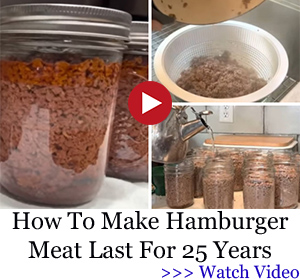 There are many other benefits of root cellars, but here are some of the most important ones:
There are many other benefits of root cellars, but here are some of the most important ones:
- Long-term food preservation
- Energy savings
- Back-up food supply for emergencies
- Decreased dependence on the globalized food industry
What Can Be Stored?
There are many ways to preserve food, but some are best kept in a root cellar to maintain better nutritive value and appeal.
Cellars are well-known for storing root vegetables like potatoes and carrots and fruits like apples and pears, but what else can you store in your root cellar?
Food to Store
First, let’s cover the most common types of food that you can store in a root cellar.
- Root vegetables, including potatoes, carrots, parsnips, turnips, beets, onions, and garlic
- Fruits, including apples and pears.
- Other vegetables, including cabbage and pumpkins.
- Smoked foods, including salt pork, smoked fish, and jerky.
- Dairy products, including butter, cheese, milk, and cream.
- Miscellaneous products, including water, tortillas, and bread.
Obviously, all of these foods have different storage requirements and some last considerably longer than others. However, your root cellar can store a lot more than you think.
Homemade Wine, Beer, and Sodas
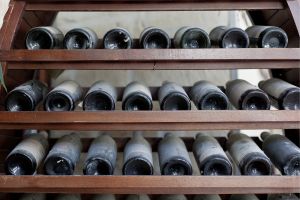 Root cellars are a great place to store homemade wine, beer, and sodas because they have very similar conditions to those needed for proper storage and aging of wine. Beer, wine, and sodas can all benefit from the cool, even temperatures that prevent spoilage, allowing flavors to develop nicely over time.
Root cellars are a great place to store homemade wine, beer, and sodas because they have very similar conditions to those needed for proper storage and aging of wine. Beer, wine, and sodas can all benefit from the cool, even temperatures that prevent spoilage, allowing flavors to develop nicely over time.
Perennial Bulbs and Flowers
While perennial bulbs and flowers aren’t edible, they need to be stored in a similar manner as the roots and tubers that we eat. Your prized dahlias can be safely kept in your root cellar, as can gladioli bulbs, begonias, and other flower bulbs and tubers.
What Can’t Be Stored?
What you can store in your root cellar depends on the climate you live in, how insulated it is, and how deep it is in the ground.
In general, keeping citrus or tropical fruits like bananas and oranges in a root cellar is not recommended. They emit too much ethylene gas and need warmer temperatures to ripen fully. You also can’t store grains in the root cellar because there is too much humidity, and they are likely to develop mold and mildew.
Related: Looming Grain Shortage. Do This Before It’s Too Late
While hard cheese is okay for long-term storage in a root cellar, soft cheeses and other dairy products won’t last long.
Ideally, your root cellar should be cool year round, maintaining a temperature between 32° and 40° F (0° and 4° C). At these temperatures, you can keep perishable foods such as milk, cream, and salad greens. However, many root cellars aren’t insulated well enough or are ventilated during the hottest parts of the day, which causes temperature fluctuations that lead to food spoilage.
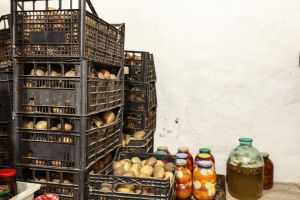 If you live in an area with a high water table, your root cellar could be too humid to store canning jars.
If you live in an area with a high water table, your root cellar could be too humid to store canning jars.
The high humidity can cause the metal to rust, ruining the seals and spoiling your food.
Knowing what to store in your root cellar may come down to experimentation.
What works in your root cellar may not work in your neighbor’s, and vice versa.
Top 8 Root Cellar Mistakes to Avoid
The best root cellar naturally takes care of many of the enemies of food storage: light, moisture, temperature, oxygen, time, and pests. However, even the best root cellars aren’t without problems. Here are some of the most common root cellar mistakes people make to lose the battle against food’s worst enemies.
Mistake #1: Not Curing Produce Before Storing It
Some vegetables need to be “cured” before going into the root cellar. For example, pumpkins will develop a hard shell if they’re allowed to sit in the sun for about two weeks. Onions and garlic are other items that need to be cured.
Mistake #2: Poor Ventilation
Your root cellar should be properly vented to eliminate stagnant air, which can lead to mold and mildew growth. Install vent pipes to exchange the stale air in with fresh air from outside.
If possible, use a timer or thermostat switch to ensure that it is only ventilated during the coolest parts of the day.
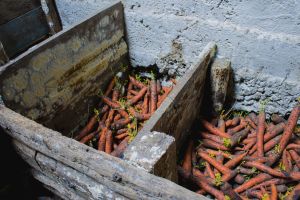
Ensuring proper ventilation is just one of many steps in creating an efficient root cellar. If you’re looking to build a cheap and effective root cellar in your backyard or want to correct mistakes in your existing one, this guide is invaluable. It provides practical tips and step-by-step instructions to help you get the most out of your root cellar.
Mistake #3: Incorrect Humidity Levels
Different types of foods require various humidity levels for proper storage. Many people accomplish this simply by putting food that needs to be drier, such as potatoes, higher up off the ground.
Food that needs more moisture, like carrots and parsnips, can be placed lower to the ground. A more scientific approach is to use hygrometers at various heights and different spots.
Mistake #4: Fluctuating Temperatures
If you were ever yelled at as a kid to close the refrigerator door to keep the cool air from escaping, then you understand what happens every time you open the door to your root cellar. Try to avoid opening your cellar during the hot parts of the day and seal up any cracks, especially around the door. And insulate everything–even your ventilation pipes.
In northern regions during the winter, you may face a different problem: freezing. If the temperature drops below 32°F (0°C), then your food will spoil.
Mistake #5: Not Keeping Certain Foods Separate
Fruits like apples give off ethylene gas as they ripen, which can make the produce around them go bad faster.
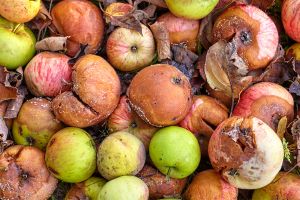
Keep apples and pears in a separate room or vent them separately if possible. You can wrap them in newspaper or keep them in a cardboard box to limit the amount of air circulation. If you make shallow wooden boxes so you can place your apples in a single layer, it’s much easier to keep an eye on them so they last longer.
Mistake #6: Keeping Onions and Garlic Low to the Ground
Onions and garlic will keep well in a root cellar as long as they maintain the right humidity. However, they do best when stored high up off the ground on a vegetable rack or in a hanging basket.
Some people hang them from therafters in old pantyhose, which allows them to breathe but keeps them off the floor. They also do better when they are cured before storing so the dry, outer skin develops.
Mistake #7: Ignoring Regular Inspections
Regular inspections will ensure that you can maintain proper temperature and humidity. During inspections, you can also rotate stock and get rid of produce that has started to go bad. But one of the most important reasons to conduct regular inspections is to prevent pest damage to your food supply.
Rats and mice have naturally evolved to live near and around humans, and they consider our food supplies to be their own. Unless you take appropriate measures, they can destroy your hard work by taking nibbles or leaving urine and feces all over the place. Prevention can include traps, essential oil sprays, and homemade remedies like neem oil and vinegar sprays.
Mistake #8: Skipping Seasonal Cleanings
Late spring is a great time to clean your root cellar, so adding it to your spring checklist is a good idea. Most of the food that you store over the winter won’t be usable after the end of spring, so you can clear out anything that remains and feed it to your chickens or weaner pigs.
Spray out your root cellar with a 10% bleach solution, which will help remediate any mold and mildew that can cause food spoilage problems.
Unlock the Full Potential of Your Root Cellar
Root cellars are invaluable, especially if you’re a gardener and you want to put up a lot of food to feed your family and prepare for emergencies.

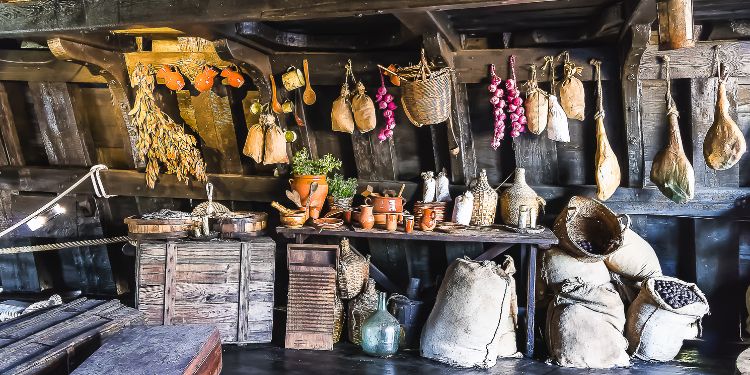
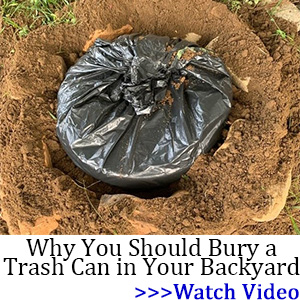













Root cellars, bunkers, hobbit holes are great if the soil is void of rocks and clay type soil. Most places require us to use gas powered equipment to dig a hole if possible. It dependents on what part of the country or location we are at that we can create a root cellar. Long time ago we had one under a small home which was also a temporary tornado shelter too.
In today’s nosy neighbor in the suburban environment it is hard to keep these private when people have security cameras of all sorts watching us.
But good primer for those that can have a root cellar and low water table areas that are dry conditions.
Yeah FEMA or Bidenomics freeloaders might find out you have a food stash available to share with the less fortunate open border hungry illegals here.
Besides worry of food shortages we have rolling brownouts coming soon as AI, Bitcoin, EV charging among other technologies will be causing the breakdown of our electrical grid foundation. While major upgrade is due, it will come too late. We have illegals by Bidenomics giving illegals married to Americans over ten years in the country. Are being giving amnesty over the migrants coming legally.
Which means another Let’s Go Brandon vote buying, as he did with student loans to get out the vote of corrupt politics at American taxpayer’s expense!
According to the root cellar calamities that can happen, would it be better to have an above ground or partially below ground structures that would have better storage conditions?
I too have crappy rocky hard soil that is impossible to dig without hiring a contractor. Which makes keeping the preps private from the public “looky-loos” such as the homeless and illegals now in practically every American town and city.
Below ground is best, my opinion – stays colder and more even temperatures year-round.
Depending on your location a root cellar needs to be monitored for pests. Rats, mice, spiders. Snakes, they all like dark cool places to be in the Summer season.
How do I do a cellar in the gulf coast swamp? If I dig down 2 feet it will fill with ground water. It’s yuk water too. Serious question. How does one store below grade in the swamp area? I grew up in the Ozarks and loved basements because they were cooler, no ac, and warmer than outside, below freezing for weeks. Anyone know how not to make a boat from a root cellar?
Some of these articles need to be taken with a grain of salt as we can not all do the same as these authors recommend. We live in various climates and variations of what we can do or not.
Take what we can from these articles and “Improvise, Adapt, Overcome.”
That was popularized by Clint Eastwood in “Heartbreak Ridge” and often associated with the U.S. Marine Corps.
Side note; at the time the filmmakers approached the story to the Army first they turned it down due to portraying an NCO as a brawny excessive drinker. Eventually they got a go from the Marines.
But today’s military would have to make changes to that unit and the sergeant to reflect low “T” tranny soldiers employed today’s military.
Ashamed the current general enlisted military branches have gotten rid of the masculine male in favor of woke politics, LOL!
If we have kinder gentler soldiers we will have kinder gentler wars.
That was painful to type and there needs to be a dedicated sarcasm font.
It is possible but it is very expensive and time consuming. I’ve worked under the water table multiple times. One time we were 35ft below the water table. I live on Long Island Ny with a water table of 4ft in some areas and we have a lot of beach sand for soil on our south shore. First you have to put n some well points. These are pipes that allow a pump to suck out all of the water so the ground is stable enough to dig in. Then you have to put in some kind of shoring. inside of the well points to hold back the dirt that might wash in. The pump will have to run the entire time the hole is open, 24/7 with out stopping or the walls will collapse in and the hole will flood. Sometime within seconds, so have a good pump and a backup pump. Then form out what you want to do. Put in a nice thick concrete floor with a pond liner under it, for water proofing. Make sure you have some rebar rods sticking out of the floor for the walls so they are anchored to the floor when you pour them next. Then form and pour the walls. Then it’s best to tar the outside of the concrete walls for water proofing and glue or tar the pond liner to the walls to futher water proof the walls. Then backfill and shut down your pumps. Backfill first because I’ve seen built in pools float out of the ground in storms in my area. Your inground concrete structure will be heavier than a pool so it’s not likely to float. Good Luck and hope this info answered your question.
Sounds expensive but it did answer my question. Thank you.